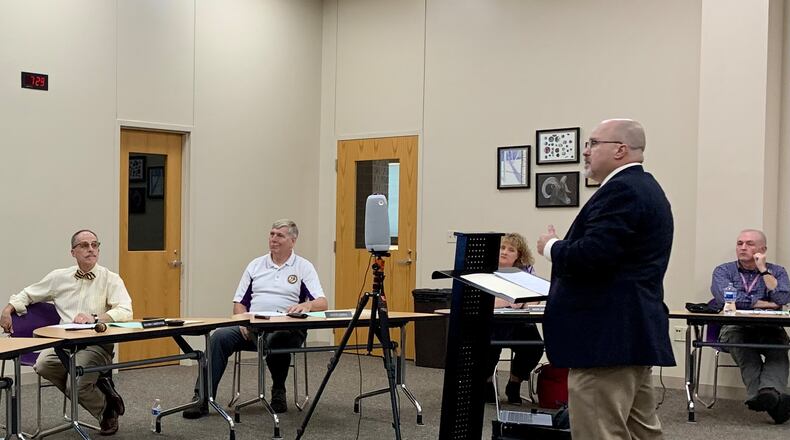The school board, Bellbrook city officials, Sugarcreek Twp. trustees, and the park district will hold a special meeting at 5:30 p.m. Monday at Bellbrook Middle School (3600 Feedwire Road) to discuss school resource officers.
Mark Carriera, president of the Sugarcreek Education Association, Bellbrook’s teacher’s union, said at the Sept. 8 meeting that the board did not consult with teachers before making their decision.
“Sitting here tonight during this presentation, I have to tell you the truth, that I feel that it’s very choreographed, and I’m very concerned that this decision is being made without any teacher input whatsoever,” Carriera said, adding that he hoped the board would open up dialogue with teachers about how the plan is to be implemented.
Logan Ashley, a former police officer and Bellbrook parent, cautioned board members to be cognizant of the environment in which they are introducing deadly weapons.
“As law enforcement officers, we always hear the term, ‘it takes a good guy with a gun to stop a bad guy with a gun.’ That situation, in my opinion, holds merit,” Ashley said. “However in the school system, it is dangerous, and does not give thought to the totality of circumstances. It is naïve for us to believe that these students aren’t going to know who is going to have that firearm. Kids talk. They are going to find out.”
Multiple school board members said during the Sept. 8 discussion that teachers carrying guns on them in a classroom setting was “out of the question.”
The school board’s resolution says rather than carrying the guns during school, response team members would be able to access “securely stored firearms” in case of an emergency. That sounds similar to a plan Mad River Schools announced years ago, where in case of emergency, trained staffers can access firearms that are stored in multiple biometric-access safes hidden around the schools.
Biometric safes require an optical scan or fingerprint of a registered user to open.
Preliminary requirements for Bellbrook’s response team participants would include undergoing an interview, passing a thorough background check and mental health screening, and completing at least 40 hours of training, with annual re-certifications. In Ohio, this is the same hourly training requirement for court officers, such as bailiffs or probation officers, who are allowed to carry weapons on school grounds.
Many local school districts have at least one school resource officer (most of them armed police) in their district. It is unknown exactly how many schools have some other type of armed response plan, as Ohio law has, for years, allowed some details of school safety plans to be hidden from public view for security reasons.
Mad River and Sidney schools locally spoke openly in recent years about plans that allowed volunteer school staff to access guns in school buildings. In 2021, the Ohio Supreme Court struck down those policies, ruling that school districts couldn’t let staff carry guns on school grounds unless those people had undergone Ohio peace officer training, or had 20 years of experience as a police officer.
More recently, House Bill 99, which went into effect Monday, removed the Ohio Peace Officer training requirement, and allowed school boards to authorize teachers and staff to carry firearms with 24 hours of firearms training.
Law enforcement officers who spoke at Bellbrook’s Sept. 8 meeting said that given the choice between putting firearms in the hands of teachers, the district would be better off hiring more school resource officers, keeping guns in the hands of trained professionals.
Detective Sgt. Lon Etchison, a Bellbrook parent, said he was in favor of a “layered approach” to school security, both increasing the number of SROs and training educators in firearms as means of deterring an attack.
“Every school facility in my opinion should have an SRO if you can fund it,” Etchison said. “Nothing is more precious than our kids. But yet we don’t protect them like it. We protect our gold and our politicians more than we do our kids.”
Hiring more SROs would cost the district roughly another $100,000 annually per officer, officials said.
“I am not a in favor of telling the employees of the Bellbrook-Sugarcreek school system, ‘Anybody who wants carry a gun, can you be up for just 24 hours and come carry,” Etchison said. “There’s got to be some sort of a good selection process. You can’t make people do this. Some people are not built to deal with this.”
Denise Moore of activist organization Sugarcreek Cares said that there is no evidence that increasing police presence in schools reduces gun violence, citing a 2022 study by the National Institute of Justice.
“We think you are proposing school policing by armed guards,” she said, adding that students of color and students with disabilities would be negatively affected by increased police presence in schools.
“Most school shootings are performed by students or former students whose needs were unmet,” Moore added. “The board would best be served to invest in greater numbers of school-based mental health providers.”
The board’s resolution does include a laundry list of other steps the district is taking, from de-escalation training for crises, to school Hope Squads aimed at preventing suicide and violence, and programs to help students dealing with trauma.
But the resolution also calls the response time of trained responders critical in the case of an active shooter.
“The Board of Education recognizes the unavoidable delay, and unacceptable resultant casualty count, involved with the cumulative time it takes for someone to recognize that an active shooting has begun, dial 911, inform dispatch of the situation, have that information relayed to offsite law enforcement officers who then begin traveling toward our schools so they can ultimately arrive and begin their search and response protocols,” the resolution says.
About the Author

